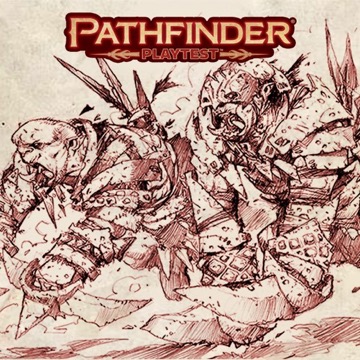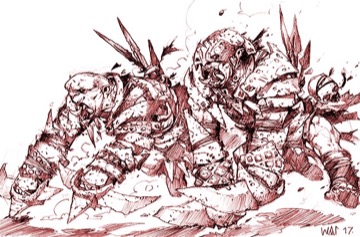We've talked in depth about many of the systematic changes and PC options in the blogs so far, but what about monsters? From animated objects to zombies, from the lowliest kobold to the mighty jabberwock, the Pathfinder Playtest Bestiary includes over 250 different monsters and other adversaries built specifically for the playtest. But what makes these monsters tick? We've worked to bring you many of your favorite Pathfinder monsters with their familiar feel and niche in the world, but with updated mechanics to make your encounters even more memorable!
Signature Abilities
One of the monster innovations I—a computer science student at the time—appreciated most in Pathfinder First Edition was the idea of the Universal Monster Rule. It follows one of the most important principles of programming: modularity, which is to say, don't reinvent the wheel. One side effect of Universal Monster Rules having been a new concept in Pathfinder First Edition, however, is that many less fantastic creatures, especially animals, had a similar suite of Universal Monster Rules. For example, owlbears are iconic and memorable creatures, but as far as their statistics, if you look at the CR 4 owlbear and the CR 4 tiger side by side, the owlbear doesn't really have anything different to use during the encounter that the tiger doesn't.
In the playtest version, those two monsters have some significantly different abilities. The tiger still has grab, allowing it to grapple a creature it hits with its jaws or claw attack, and the pounce action, allowing it to Stride and then Strike. Based on its real-world fighting style, it now also has wrestle, allowing it to claw a creature it's grabbed and knock it prone, and sneak attack, granting it extra damage against flat-footed creatures (typically ambushed via Stealth or those prone from its wrestle). Meanwhile, the owlbear also still has grab, but once it has you grabbed, it can gnaw on you, hoping to disembowel you so it can devour your guts and later regurgitate them to feed its young—and potentially making you sick from the disgusting sight. It can also unleash a blood-curdling screech as it advances into the fight to frighten you.
In general, giving interesting new abilities to real-world animals like the tiger allowed us to do some fun research into the animals' habits and design from there. Animals that hunt in packs sometimes have abilities to deal extra damage in groups, ambush predators use sneak attack and various sneaky tactics, and so on.
Dynamic Defenses
In Pathfinder First Edition, damage reduction (DR) and energy resistance both reduce damage by a set amount, the rarer vulnerability multiplies damage by 1.5, and immunity flat-out prevents certain abilities from functioning. Taken as a whole, monster defenses generally penalize you for using the wrong thing; you can deal your normal damage only by correctly bypassing DR, resistance, and immunities, and monsters rarely have a vulnerability. But in stories, we often imagine fey as being burned by cold iron or werewolves being poisoned by silver, and the reality of DR is that they just take the same damage from those as they do from cold, electricity, or fire. To fit those stories and to vary things up, we've combined DR and energy resistance into resistance, which reduces damage by a set amount, and we've changed vulnerability into a more common element called weakness, which increases damage by a set amount.
Two great examples of how this can dramatically change the feel of monsters are skeletons and zombies. A level 0 skeleton has 14 AC, 6 HP, and since it's made of bone, resistance 5 to slashing and piercing damage. A level 0 zombie, on the other hand, has 11 AC, 20 HP, and weakness 5 to slashing damage. The zombie takes 5 extra damage every time it's hit by a slashing weapon—that's an extremely high weakness! This means the fights feel very different, even though the creatures both take about the same number of swings to bring down. You can test this out for yourself in Pathfinder First Edition right now: consider giving zombies some extra HP and changing their DR into a weakness instead and see how the feel of the fight shifts!
Sweet Suites
Some monsters in Pathfinder First Edition have a large suite of abilities (typically from long lists of spell-like abilities), which vary between key iconic abilities, story abilities that influence what the monster can do in the narrative, and other abilities that are niche, redundant, or sometimes much weaker than their other attacks. For instance, it's pretty unlikely a nalfeshnee's call lightning is a good idea for a CR 14 monster to use in combat, and it doesn't have much of a noncombat application, either. In Pathfinder Second Edition, we tried to keep a monster's iconic abilities and story abilities while removing redundant or niche abilities, and then adding something new that fits the monster's ecology. For instance, barbed devils don't have the equivalent of order's wrath or unholy blight, but they have a special power called Warden of Erebus that lets them create extremely versatile glyphs of warding, cementing their role as, well, wardens of Erebus. For all such monsters, the goal is to make the monster's suite of abilities much easier to use and more memorable without oversimplifying the monsters, following our overall goal of adding as much depth to the game as possible while minimizing the cost in complexity.
I Have Multiattack
To close off, many people have been wondering how in the world we handle creatures with many heads, like the hydra, or arms, like the marilith or hekatonkheires, in the 3-action system. Such creatures have unique abilities to use their attacks in tandem in different ways. For instance, a marilith has three options for her six blades. She can make a focused assault on one enemy, which can deal a massive amount of damage on a hit, and deals damage for a single longsword even on a failure (but not a critical failure). Alternatively, she can spin about like a whirlwind of blades, attacking up to six different creatures with her swords. Finally, she can just attack twice and use the other blades to parry, giving her a killer AC for 1 round.
That's it for monsters for today; tune in on Friday as Logan goes through an example monster in detail and shows how we made the statblock easier to reference!
Mark Seifter
Designer









